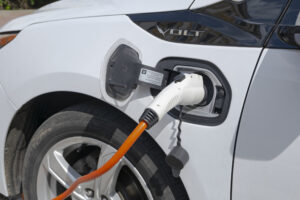
GM launches free EV online training course for first responders
By onAnnouncements | Repair Operations | Technology
General Motors (GM) has launched a free online training course for first responders who work crashes involving an electric vehicle (EV), according to a press release.
The training, produced in collaboration with the Illinois Fire Service Institute, is a six-video course that includes introducing first responders to basic EV concepts and fire suppression techniques.
“Electrification is here and it is real and it is happening now,” says Joe McLaine, GM staff engineer, in the 15-minute introduction video.
McLaine briefly discusses multiple issues in the video, such as specific needs when towing EVs because of regenerative braking that creates energy and sends it to the battery pack. He said EVs should be towed on a flatbed or using dollies that prevent the wheels from spinning.
“We don’t want you towing these vehicles when the battery back doesn’t have the ability to accept the energy,” McLaine says.
He also highlights a few ways first responders can identify a vehicle is electric upon arrival at a scene. This includes observing no tailpipes or radiator grilles. Badges or emblems could identify some vehicles as EVs, he said. However, he added consumers could take the badges off the vehicles.
Some states identify EVs on the license plate, he said. Dispatch could also help in identifying a type of vehicle through connection with services, such as OnStar.
McLaine also provides information about emergency response guides and rescue sheets that GM has created for first responders.
OEM1Stop.com is an industry site, developed by automakers, to provide access to vehicle repair and service information including emergency service guides for first responders written by OEMs. The guides include proper battery removal and storage guidance and information about what should happen once the vehicle is brought inside the repair facility.
The Energy Security Agency (ESA) also staffs a 24/7 Guidance Center for first responders, towing and recovery, recyclers, salvage yards, and the repair industry to answer questions about handling EV and hybrid vehicles properly.
The center can walk through risk assessments and help each party label the vehicles with color-coded stickers that warn others of potential risks.
McLaine also addressed other issues, such as warning first responders that they need to be cautious of charging stations that are likely increasing in number in communities throughout the nation.
“These charging stations may not be installed correctly or may be subject to vandalism or other forms of mistreatment in your communities,” McLaine warns.
The other videos in the training series are named:
-
- “BEV Basics and Electrical Concepts”
- “Incident Response and Rescue Documents”
- “Battery Packs and Fire Suppression”
- “Connected Vehicle Services, OnStar, and Extrication”
GM states it has provided hands-on training to 5,000 first and second responders from 700 different departments and agencies in the United States and Canada in the past two years.
National Fire Protection Association offers numerous EV training online for first responders and the general public, including a training session for vehicle dealerships. The U.S. Department of Energy website also lists EV fire training resources.
A recent Alliance for Automotive Innovation (Auto Innovators) report found 378,000 EVs were sold nationwide during Q3 2023, a 63% increase over Q3 2022.
It said EVs represented 10.1% of new light-duty vehicle sales. As of Q3, there are 111 EV model cars, utility vehicles, pickup trucks, and vans on the market, the report said.
Last year, the Biden administration also released funding for EV infrastructure as he originally pushed for half of all vehicle sales to be electric by 2030. However, the New York Times recently reported Biden plans to relax on his EV timeline to gain favor in the upcoming election. He is now expected to push production requirements to after 2030.
States have also pursued EV plans with California taking the lead. The state is requiring all automotive sales to be electric or hybrid by 2035. More than a dozen states have adopted California’s rules but at least one, Connecticut, is reconsidering after hearing about Biden’s new plans.
IMAGES
Photo courtesy of Tramino/iStock
